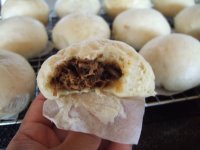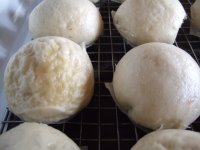Chuuka Manjuu, Japanese-style Chinese steamed buns
The dough:
- 6 cups of all-purpose flour (if you can find bleached flour, which we can't here in Switzerland, the buns will be whiter than white like they are at that store on Pacific Avenue)
- 2 packages dry yeast
- 1/2 cup sugar
- 1/4 cup lukewarm water
- 1 cup boiling water
- 1 cup warm whole milk
- 2 Tbs vegetable shortening or lard
- 1 tsp. baking powder
- Parchment paper
Cut up the parchment paper into 24 squares about 10 cm / 3 inches square.
Proof the yeast in a bowl or cup in the 1/4 cup of warm water with a pinch of sugar added, until foamy.
In a large bowl, put in 5 cups of the flour. Make a well in the center, and add the hot water and mix rapidly. (Hot water seems to bring out the sweetness in flour.) Add the sugar and yeast/water mixture, baking powder, warm milk, and the shortening or lard. Mix well. Add the rest of the flour little by little until you have a workable dough. Knead for a few minutes on a floured board until it's soft and pliable. (This dough is one of the easiest you'll ever encounter.)
Put into a large plastic zip bag and seal. Leave in a warm place until the dough has doubled in bulk, or has filled up the bag until it looks ready to burst. (About 45 minutes).
Take out the dough and roll into one long sausage. Cut the dough into 24 pieces. Roll each piece into a ball, and let rest for a bit.
To fill the buns, flatten each ball so that the middle is slightly thicker than the edges. Put about a tablespoon or so of filling in the middle. Gather up the edges and pinch them firmly together to seal, then turn the bun over and place on a square of parchment paper. Let the buns rise for 15-20 minutes before steaming.
Steam in a steamer for 20 minutes. Eat while piping hot. I like to dip mine just slightly in soy sauce mixed with mustard sauce (the kind made straight from dry mustard powder, like the little packets you get at a Chinese take away).
The pork filling:
- 400g / a bit less than 1 lb of char siu (Chinese-style roast pork, recipe follows)
- 1 cup finely chopped green onions
- 6 dried shiitake mushrooms
- 1/4 cup of canned bamboo shoots (optional)
- 2 tsp. dark roasted sesame oil
- 1 piece of fresh ginger, chopped finely
- 3 Tbs soy sauce, or the defatted roasting liquid from the char siu
- 1 Tbs flour
- 2 Tbs cornstarch
- 1/2 cup water
Soak the shiitake mushrooms in warm water until soft. Cut off the hard stems and slice thinly.
Cube the pork, or chop it up finely.
Mix the flour and cornstarch with the water.
In a pan heat the sesame oil and toss in all the ingredients except the flour/cornstarch water. Sauté briefly, then add the flour/cornstarch water. Cook until it's a bit syrupy.
Let cool and use to fill the buns.
Yakibuta, or Japanese-style Chinese Roast Pork (char siu)
- A pork roast that is at least 1 kg (about 2 lbs). It should not be too fatty, but should not be totally lean or it may be rather dry.
- Soy sauce
- 1 fat piece of ginger
- 1 star anise
- 3-4 garlic cloves
- Sugar
- Water
If you have a big piece of pork, cut it into about 500g (1/2 pound) pieces. Roughly chop the ginger - you can leave the skin on - and bash the garlic to crush a bit.
Put the pork pieces in a sturdy plastic bag. You may want to double-bag it. Put in the pork, ginger, star anise and garlic, and fill with enough soy sauce to cover the pork. Seal the bag well and marinate in the refrigerator overnight. Turn the meat several times if you can so that the marinade penetrates evenly.
Preheat the oven to 140° C / 280° F. Empty out the contents of the bag into a baking dish. Add a bit of water so that the meat is sitting in about 1cm of liquid. Sprinkle the meat with sugar, and bake for about 2 1/2 - 3 hours, turning the meat every 20-30 minutes. If you want it even sweeter, sprinkle more sugar on the meat periodically. At the end, the liquid will be almost gone and syrupy, and you will have dark amber colored pieces of pork. Let cool and slice thin, cube, etc. You can use cubes in fried rice, or in the steamed buns of course, and any number of things. Sliced thin it makes a great salad. It's also a rather unusual tasting sandwich meat.
It is quite worthwhile to make this in some quantity, since the cooking takes so long, and to freeze in portions for later use.



